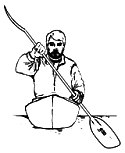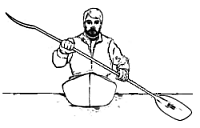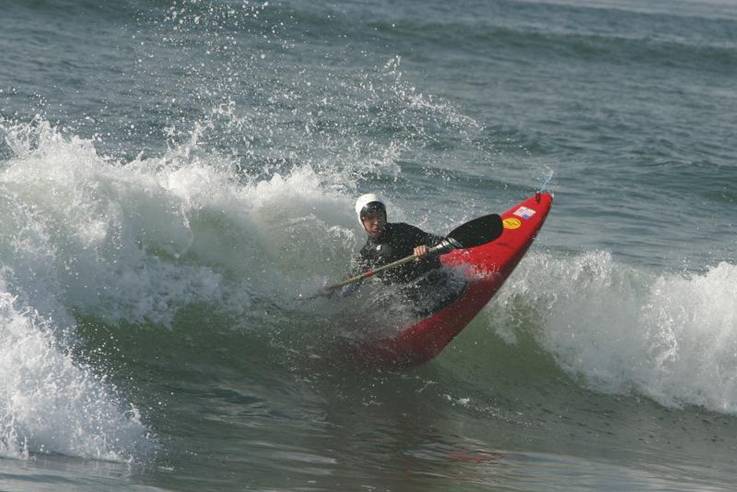
 |
|
|
#1 |
|
bing!
Join Date: Mar 2007
Location: socal
Posts: 246
|
Paddle Talk
Here is some useful info ... The truth about kayak tracking - The real truth, according to a leading kayak experts, is that "tracking" is 80% paddling and 20% design. Tracking IS paddling. Proper paddle hand placement - To find your hand placement on your paddle, start by placing the center of the paddle on the top of your head, your elbows should form more or less a 90 degree angle between the forearm and upper arm. There should be an equal amount of paddle shaft and blade beyond both of your hands. In buying a paddle, know if you are a low angle or high angle paddler. High angle paddler  Low angle paddler  The angle of your paddle technique will dictate how long your paddle should be, and what style of blade you should get. The high angle paddler (when the paddle enters right next to the hull) is more suited for surf, white water as it provides more power per stroke. It is also easier to control the kayak while "surfing" due to the usual short length of a high angle paddle (210-220cm). A disadvantage is that it has a tendency to provide less tracking "feel" for the novice. A paddle for the high angle style is properly sized to the paddler when it has between 1 to 3 palm widths between the paddle and the hand grip placement. Picture of a kayaker using a bracing stroke to control the kayak in a surf environment. In this picture, it is apparent how a longer paddle will be a disadvantage and a shorter paddle easier to control.  Note the symmetrical blade style preferred for its power in this photo  High angle paddle blade style  Another high angle blade  Here is a video of a high angle paddler... http://www.expertvillage.com/videos/...ard-stroke.htm Low angle paddling is the usual touring / long distance style. It may provide less power due to the stretched out water entry of the blade (about 1.5 to 3 feet from the side of the hull) and also the blade style. You will get more tracking "feel" as the leverage of the stroke will give the paddler immediate feedback to the kayaks bow. Low angle kayak paddle are usually 230-240 cm long. A paddle for the low angle style is properly sized to the paddler when it has 3 or more palm widths between the paddle and the hand grip placement. Picture of low angle paddle blade  Traditional eskimo touring paddle blades  Low angle paddling conserves energy and provides a more relaxed pace. Surf launching with a "longer" low angle paddle is a bit more difficult because of the "usually" thinner blade, larger leverage of a longer paddle. How to hold your paddle http://www.expertvillage.com/videos/...ing-paddle.htm Turning by edging http://www.expertvillage.com/videos/...ing-edging.htm If there is interest in pursuing this subject further, I do have some more info. Also, if you have your own tips, post it right here. Last edited by peguinpower; 11-19-2007 at 08:14 PM. |
|
|

|
|
|
#2 |
|
Fish On !!!
Join Date: Dec 2006
Location: San Diego, CA
Posts: 194
|
interesting info.
thx. i'm so bad with surf paddling, i can use all the knowledge i can get.  .
__________________
Hobie Kayaks: Use Your Legs to Pedal.... Use Your Arms to Fish !!   Kayak Fishing is a DRUG.... and I'm addicted !! 
|
|
|

|
|
|
#3 |
|
Senior Member
Join Date: Aug 2007
Location: south park (san diego),CA
Posts: 119
|
holy crap! i'm a high angle paddler with a low angle paddle. thanx, i think i need to look at other paddles or relearn my stroke
|
|
|

|
|
|
#4 |
|
bing!
Join Date: Mar 2007
Location: socal
Posts: 246
|
Size Matters -
excerpted from an article by Wes Kisting Once you've decided which blade design appeals to you, you'll need to determine which size (length) of paddle best fits your height, your paddling style, and your kayak. Kayak paddle lengths are almost always listed in centimeters (cm), and for the average recreational or touring kayak, you'll need something in the 210 cm to 240 cm range. Here's one basic rule of thumb that many retailers use to size kayak paddles to their customers: Standing next to the paddle, reach one arm up over your head and see if you can curl your fingertips over the top of the paddle blade. If you can't reach the top of the paddle, the paddle is too long. If you can reach your whole hand over the paddle, the paddle is too short. If you can just curl your fingertips over the top of the paddle, the length is right for you.Based on this rule, a paddler who is 5'10" to 6'1" tall would need a kayak paddle in the 220 cm to 230 cm range—and indeed, these are usually the most common lengths that you will find in paddle shops. Shorter, smaller-framed paddlers can use a 210 cm paddle, and taller, large-framed paddlers can use a 240 cm paddle. But there are still a few other factors that need to be considered. One of these is the width of your kayak. The finger-curl test for sizing a paddle works fairly well if you're selecting a paddle for a kayak 20 to 25 inches wide, but if your kayak is wider, you may need a longer paddle to help you extend the blades beyond the sides of the kayak and submerge them fully in the water. If you're paddling a kayak with a width of 28 to 30 inches, for example, you might need a 230 or 240 centimeter paddle—even if you're only, say, 5'5" tall. Otherwise, the constant banging of paddle blades against the side of your boat may drive you crazy, or it may prove difficult to fully submerge the blades during your normal stroke without awkwardly reaching or leaning to each side. In either case, your paddling performance and enjoyment will suffer. In recent years, the trend among many kayakers has been to use shorter paddles. The trick is to buy a paddle that has just enough length to get the blades fully into the water (without reaching or leaning to either side). If your paddle is longer than it needs to be, you will need to put extra (unnecessary) effort into your stroke because the water will have more leverage against you. On the other hand, some kayakers believe that a slightly longer paddle adds a little extra length or "fullness" to your paddling stroke, allowing you to accelerate more quickly and to maintain cruising speed with a slightly slower cadence. Again, we're talking small, perhaps negligible differences. If you're one of those paddlers who seems caught "in between" two sizes, I think it's smarter to err on the side of the slightly longer paddle (if for no other reason than to avoid grating your knuckles against the deck during each stoke). Having said that, I do recommend sizing your paddle as short as convenience permits because a shorter paddle weighs less and, as I mentioned, give the water less leverage against you, thus reducing fatigue. On an even more practical note, shorter paddles make it easier to keep your kayak moving in a straight line. Why? Because the further out you paddle to either side of your kayak, the more turning leverage you exert in your stroke. Extra paddle length means more turning leverage, causing the bow to wander side-to-side a little more with each stroke. Ideally, you should keep your paddle blades tucked in as close to your kayak as possible because a closer, more upright stroke (called a "high angle paddling style") transfers more of your stroke's power into straight, forward movement. Obviously, this is much easier to do with a shorter paddle because the blades will be closer to your kayak to begin with. In fact, if you find yourself zig-zagging all over the lake even on calm days, part of the problem may be that you're using a paddle which is much too long. Consider downsizing. |
|
|

|
|
|
#5 |
|
Member
Join Date: Mar 2006
Location: Torrance. ca
Posts: 76
|
Any tips on Pedaling? lol
Great info! Aaron |
|
|

|
 |
|
|